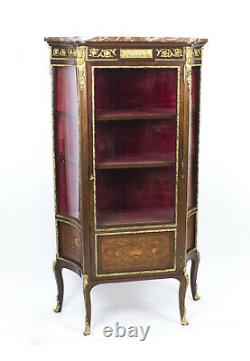
- Home
- Department
- Features
- 8-day (17)
- Aceo, Miniature (6)
- Antique (31)
- Boxed (6)
- Carvings (25)
- Decorative (17)
- Dragon-antiques.com (6)
- Framed (30)
- Framed, Signed (5)
- Gilded (76)
- Gilded, Pair (67)
- Hand Painted (14)
- Limited Edition (7)
- One Of A Kind (ooak) (12)
- Ornate (12)
- Pair (129)
- Reclaimed (13)
- Salvage (47)
- Signed (17)
- Updated Wiring (7)
- ... (3026)
- Material
- Subject
- Theme
- Type
- Andiron (21)
- Armchair (64)
- Candelabra (32)
- Candlesticks (39)
- Chandelier (98)
- Clocks (33)
- Desk Clock (28)
- Flatware - Sets (34)
- Lamps (26)
- Mantel Clock (21)
- Mirrors (39)
- Painting (45)
- Photo Frame (26)
- Picture Frames (46)
- Print (25)
- Sconce (228)
- Side Table (22)
- Sofa (47)
- Vase (23)
- Wall Clock (20)
- ... (2653)
Antique French Louis Revival Parquetry Display Cabinet 1870



Regent Antiques has been trading in London for three decades. We specialise in English and Continental antique furniture, silver and porcelain.
Our main markets are Europe and North America and we export worldwide. Antique French Louis Revival Parquetry Display Cabinet 1870. This is a beautiful antique French. Mounted display cabinet in the French.
Manner, circa 1870 in date. This beautiful cabinet has an abundance of exquisite. Mounts as well as intricate inlaid parquetry and marquetry decoration.It has shaped glass to the front and sides, stands on elegant slender cabriole legs and has three shelves to display your collectables. It is surmounted with an exquisite "Rosso Carpazzi" marble top and it will add a touch of unparalleled style to your home.
It is perfect for displaying your collection of silver or porcelain. Condition: In excellent condition having been beautifully restored and relined in our workshops, please see photos for confirmation.
Height 160 x Width 90 x Depth 38. Height 5 foot, 3 inches x Width 2 foot, 11 inches x Depth 1 foot, 3 inches.
Mahogany is probably one of the largest'families' of hardwood, having many different varieties within its own species. It became more of a Victorian trend to dress Mahogany with these decorative veneers, such as Rosewood, Kingwood, Burr Walnut and Coromandel, so that the actual Mahogany was almost hidden from view.
Mahogany itself is a rich reddish brown wood that can range from being plain in appearance to something that is so vibrant, figured and almost three dimensional in effect. Although Mahogany was most often used in its solid form, it also provided some beautifully figured varieties of veneer like'Flame' Mahogany and'Fiddleback' Mahogany (named after its preferred use in the manufacture of fine musical instruments). Cuban Mahogany was so sought after, that by the late 1850's, this particular variety became all but extinct. (from French'or moulu', signifying ground or pounded gold) is an 18th-century English term for applying finely ground, high-carat.The mercury is driven off in a. Leaving behind a gold-coloured veneer known as'gilt bronze'. The manufacture of true ormolu employs a process known as mercury-gilding or. In which a solution of.
Is applied to a piece of. Or bronze, followed by the application of an. The item was then exposed to extreme heat until the mercury burned off and the gold remained, adhered to the metal object. No true ormolu was produced in France after around 1830 because legislation had outlawed the use of mercury.
Therefore, other techniques were used instead but nothing surpasses the original mercury-firing ormolu method for sheer beauty and richness of colour. Is the most common modern technique.Ormolu techniques are essentially the same as those used on. Empire style , is an early-19th-century design.
Followed in Europe and America until around 1830. The style originated in and takes its name from the rule of Napoleon I.
In the First French Empire. Where it was intended to idealize Napoleon's leadership and the French state. The style corresponds to the Biedermeier. Style in the German-speaking lands, Federal style. In the United States and to the Regency style.
The previous style was called Louis XVI style. The Empire style was based on aspects of the Roman Empire. It is the second phase of neoclassicism which is also called "Directoire", after a government system. Furniture typically had symbols and ornaments borrowed from the glorious ancient Greek and Roman empires. The furniture was made from heavy woods such as.
Imported from the colonies, with dark finishes often with decorative bronze mounts. Marble tops were popular as were Egyptian motifs like sphinxes, griffins, urns and eagles and the Napoleonic symbols, the eagle, the bee, the initials "I" and a large N. Gilded bronze (ormolu) details displayed a high level of craftsmanship. Take a tour of our London showrooms. Take Piccadilly line to Manor House station.
Go to top of escalators and turn left. Take exit 7 and walk straight on for 10 metres. Manor Warehouse is on the right. There is car parking available on site. Please make all cheques payable to Regent Antiques.
Bank details: Regent Antiques - BBVA - Account: 05701615 - Sort: 23-59-11. For the best value, we recommend offsetting this cost by purchasing multiple items. The item "Antique French Louis Revival Parquetry Display Cabinet 1870" is in sale since Monday, November 28, 2016. This item is in the category "Antiques\Antique Furniture\Cabinets\Victorian (1837-1901)". The seller is "regentantiquesuk" and is located in London N4 1BX.
This item can be shipped worldwide.
